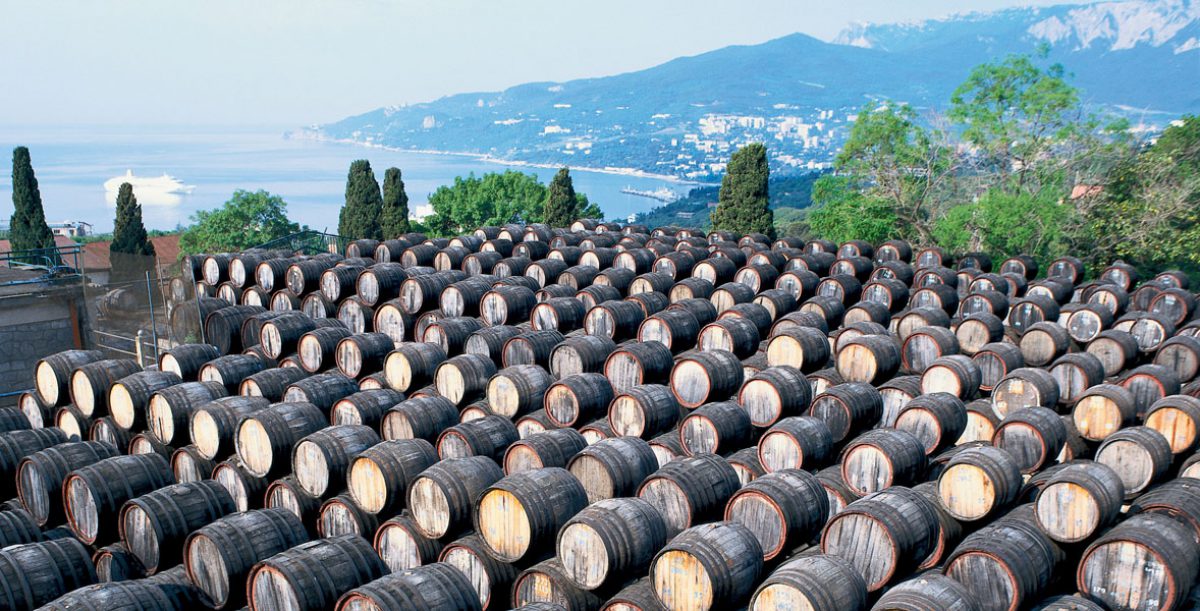“but who would believe that an experienced professional would develop a major weakness for a winery in… Ukraine?” (Frank Martel, director of fine and rare wines at Heritage Auctions)
De “Telegraaf”, februari 2016, Felix Wilbrink
Sherry
Ik ben een avondje op les gegaan: sherry proeven. Al eerder brak ik hier een lans voor de good old sherry. Mijn grootouders verbleven’s winters in Spanje en werden grote sherrykenners. Zij waren aanstekelijk keurige borrelaars, met uitgetelde zoutjes op een mooi glazen schoteltje en prachtige glaasjes ijskoude sherry. Hun jonge kleinzoon kon er niet vroeg genoeg mee kennismaken…! De Fino, de Manzanilla, de Amontillado, Olorosso en Palo Cortado kwamen nu opnieuw voorbij. Eén fles in het bijzonder viel op: een Amontillado genaamd Oreanda van de Krim. Ja, dat stuk dat de Russen weer hebben ingepikt. Maar verdorie, wat een wijn (via de sherrymethode gemaakt). Hier nauwelijks te verkrijgen. Mocht je ’m wel zien: kopen! Of mij mailen!
Verdorie, wat een wijn!
Enkele tweets na Wineprofessional 2014



Enkele passages uit “news/briefing” voor de veiling van 2013 door Heritage Auctions, het op 3 na grootste veilinghuis ter wereld. Daaronder vindt u het gehele bericht.
Wines Fit for a Tsar (fall 2013)
“the Sherries make for some of the most outstanding drinking imaginable”
By Frank Martell (Frank Martell is director of fine and rare wine at Heritage Auctions) www.ha.com
“but who would believe that an experienced professional would develop a major weakness for a winery in… Ukraine?”
“There is a lot to love in the story and wines of Massandra, then and now.”
“what really launches Massandra into the stratosphere of collectibles is the unyielding quality of everything produced throughout the history of this great estate.”
“In August 2007, I was fortunate enough to visit Massandra, where I was spoiled with an extremely comprehensive sampling. We tasted across dozens of horizontals and verticals — over 90 wines going back as far as the late 1700s. There are not many places in the world where that is possible,”
“Interestingly, the grapes (and therefore the wines) achieve an extraordinary level of ripeness because of the climate, and so they are extremely sweet and low in acid — so the spirit (grain alcohol meant to fortify) actually helps to create an unusual but precise and elegant balance.”
“but what is most staggering is the degree of consistency and transparency produced throughout many decades and including modern vintages.”
“the Sherries make for some of the most outstanding drinking imaginable”
“The Muscats… must be tasted to be believed”
“Massandra in many ways owns a bigger part of my heart than the classics because there is so much more than quality in the bottle.”
“You don’t have to love sweet or fortified wines to enjoy drinking these remarkably poised wines, which is yet another value added”
Hieronder het gehele artikel
Wines Fit for a Tsar
By Frank Martell (Frank Martell is director of fine and rare wine at Heritage Auctions)
Auction specialists are driven by an irrational compulsion to handle the rarest and most precious relics in our respective fields. As director of fine and rare wine at Heritage Auctions, those needs are fed regularly.
Dealing with the most exclusive property each day is a luxury that cannot be overestimated, but we also have things that we find unusually satisfying — intellectually and emotionally. These are items that are perhaps not the most expensive or rare but still hold a warm spot in our hearts, simply because they are so incredibly cool. They are items that speak to our inner geek, despite falling outside the realm of what is traditionally coveted.
For example, one expects to find greatness in the vineyards of France. Indeed, great estates like Lafite and Romanee Conti were identified centuries ago as vineyards of exceptional quality — and being surrounded by wines of this caliber provides a certain sense of satisfaction. Italy, Spain, the United States and Australia have also put forth some superlative estates, but who would believe that an experienced professional would develop a major weakness for a winery in… Ukraine?
In the early 1800s, Count Mikhail Vorontsov settled on the south coast of Crimea and planted vines with his heart set on making wines to rival the classics produced in France, Spain, Portugal and Hungary. He began the work of building a winery which would later be replaced by a grand Chateau cut into the granite mountains of Crimea. In the mid-late 1800s, winemaking was assumed by Prince Lev Golitzin, who concluded that greatness would not be achieved by emulating the dry reds of France, but rather by taking advantage of the subtropical climate and fashioning dessert and fortified wines of amazing distinction and individuality. The Massandra Winery was then built between 1894 and 1897 before immediately setting to work providing wines to Tsar Nicholas II at his summer palace Livadia — and the rest is history.
There is a lot to love in the story and wines of Massandra, then and now. There is the incredible facility that stores these wines in virtually unchanging conditions, deep underneath the main edifice. It took 300 workers more than three years to carve those tunnels into the stone by hand, including a flue at the end of each which could be adjusted to control the amount of cold mountain air brought into the caverns as needed. There is the obvious historical importance of the winery and facility, considering the fact that many wines produced before 1917 were made to be served to the Tsar and his guests, since the exclusive rights to production of these wines were held by Romanov’s Royal Family. There are fascinating stories describing the survival of all these wines in the collection throughout long periods of political unrest and world war. Wine lovers can find themselves overwhelmed by these narratives and others, but what really launches Massandra into the stratosphere of collectibles is the unyielding quality of everything produced throughout the history of this great estate.
The Massandra Collection simply does not include any sub-par wine. The facility today is responsible for vinifying and bottling wines produced by a number of local facilities which care for around 5,000 hectare that is planted under vine. There are dozens of unique microclimates along the coast, not all of which are included in the top cuvees — so they can afford to be very selective about what bears the standards set forth by the incredible history of this estate. Many of these wines are still being produced in continued tradition, using old methods and only moderately updated technology — but what is most staggering is the degree of consistency and transparency produced throughout many decades and including modern vintages.
Tremendous Character
In August 2007, I was fortunate enough to visit Massandra, where I was spoiled with an extremely comprehensive sampling. We tasted across dozens of horizontals and verticals — over 90 wines going back as far as the late 1700s. There are not many places in the world where that is possible, much less so pleasant. To say that the wines are delicious, or exquisite, is utterly inadequate — but it’s a starting point.
Virtually everything we tasted over the course of three days was fortified, but rather than being fortified with Cognac or Brandy, they use grain alcohol. Interestingly, the grapes (and therefore the wines) achieve an extraordinary level of ripeness because of the climate, and so they are extremely sweet and low in acid — so the spirit actually helps to create an unusual but precise and elegant balance.
The Muscats and Cabernet Ports must be tasted to be believed while the Tokay of Ai Danil remains legendary and the Sherries make for some of the most outstanding drinking imaginable. There is tremendous character and quality in every varietal they produce, but the greatest sweet wine I have ever tasted was the 1914 Massandra Malaga, which was so good as to be difficult to describe. I don’t know if it is more impressive that one glass stands out in my mind among the many legends I have tasted, or that I can’t think of a single wine we tasted that I didn’t enjoy. Wine lovers understand that taste is only a part of what makes a wine valuable.
Scarcity and quality together make something marketable, but there are so many other things that contribute to the cool factor of what we find precious. Massandra in many ways owns a bigger part of my heart than the classics because there is so much more than quality in the bottle. I love La Tache, and on the day I can afford to buy the vineyard you will see exports drop to a staggering zero bottles per year while my popularity rises and the attendance at my parties climbs steadily. I love the wines of Pride Mountain, because the wines are delicious and because the people behind the label are so exceptional. All that said, I love sharing Massandra because it is unusual, and because it sparks the imagination and drives conversations about history and the world we live in.
You don’t have to love sweet or fortified wines to enjoy drinking these remarkably poised wines, which is yet another value added. Massandra does not produce the most expensive wines on earth, but they are incredibly interesting, delicious and precious — compelling, even — and my inner geek really digs that.
